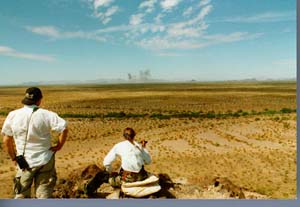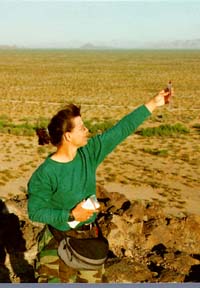| Sonoran Pronghorns and Air Force Overflights Monitoring the effects of military activity On a cool winter morning in February 1998, a professor, a technician and a graduate student in the School of Renewable Natural Resources drove to the Barry M. Goldwater military refuge near Ajo. They arrived at dawn, set up their binoculars and spotting scopes at one of four designated spots, opened their notebooks and waited. When the bombing and strafing of military exercises began about three to seven kilometers away, the research team recorded the number and behavior of any pronghorn antelope that were in the area.
This was the beginning of a three-year project that will answer questions about the well-being of the Sonoran pronghorn, an endangered species, on military proving grounds that have been overflown for 40 years. The study began after years of negotiations with the United States Air Force. Luke Air Force base is sponsoring the study in cooperation with the Air Force Center for Environmental Excellence and the University of Arizona College of Agriculture ( where the School of Renewable Natural Resources is housed), the U.S. Fish and Wildlife Service, and Arizona Fish and Game. The UA is handling the actual monitoring and data collection, and submits monthly reports to the Air Force. Paul Krausman, a professor in the School of Renewable Natural Resources and leader of the project, supervises a crew of technicians and graduate students who meticulously track the pronghorns’ whereabouts. They observe their behavior before, during and after the military exercises, at four different locations that are two to ten kilometers apart. "Game and Fish has radio collars on several animals, which helps us locate them," Krausman says, "but most of the pronghorn we’ve been able to observe do not have radios." Besides observers, the project also includes a team of technicians and graduate students who go out to the range each morning when there will be live fire, to search that particular area for pronghorn. If the animals are found in the vicinity, the Air Force calls off active fire within three kilometers of the animals. "What’s nice about this project is that involves cooperation," Krausman says. "The only way a project like this can succeed is if you cooperate with the stakeholders. That is the case here." Krausman notes that the university’s neutral, scientifically-oriented stance toward research can help in sensitive situations like this, where objective data are needed amid conflicting opinions regarding wildlife. "Unbiased research can help answer questions," he says.
The preliminary results of this study may be surprising to those who might expect the explosions and fast-moving aircraft to affect the pronghorn in at least some way. "So far, we’ve had more than 500 hours of observation time, and about 100 instances of pronghorn interacting with overflights," Krausman says. "Out of that, we’ve had no detectible responses to military activity. The animals are behaving the same as before, after and even during overflights." In the next phase of the project, he plans to address possible hearing losses among the pronghorn, that might account at least in part for their apparently normal behavior. "Because the pronghorn are an endangered species we can’t capture them, but we can capture desert mule deer, a similar species, and test their hearing," Krausman says. Krausman plans to capture mule deer from the range and test their hearing, then also test mule deer from off the range that have not been subjected to the overflights. They will measure their auditory brain stem response to noise levels. The team has already established that desert mule deer have the same hearing ability as pronghorn. Article Written by Susan McGinley, ECAT, College
of Agriculture Researcher:
|

